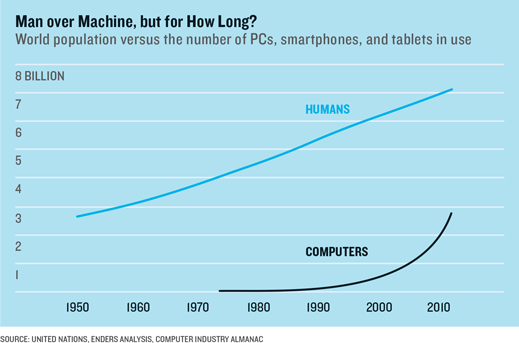Software That Augments Human Thinking
The IBM computer Deep Blue’s 1997 defeat of world champion Garry Kasparov is one of the most famous events in chess history. But Kasparov himself and some computer scientists believe a more significant result occurred in 2005—and that it should guide how we use technology to make decisions and get work done.
In an unusual online tournament, two U.S. amateurs armed with three PCs snatched a $20,000 prize from a field of supercomputers and grandmasters. The victors’ technology and chess skills were plainly inferior. But they had devised a way of working that created a greater combined intelligence—one in which humans provided insight and intuition, and computers brute-force predictions.
Some companies are now designing software to foster just such man-machine combinations. One that owes its success to this approach is Palantir, a rapidly growing software company in Palo Alto, California, known for its close connections to intelligence agencies. Shyam Sankar, director of forward deployed engineering at the company, says Palantir’s founders became devotees while at PayPal, where they designed an automated system to flag fraudulent transactions. “It catches 80 percent of the fraud, the dumb fraud, but it’s not clever enough for the most sophisticated criminals,” says Sankar.

PayPal ended up creating software to enable humans to hunt for that toughest 20 percent themselves, in the form of a suite of analysis tools that allowed them to act on their own insights about suspicious activity in vast piles of data rather than wait for automated systems to discover it. Palantir, which received funding from the CIA, now sells similar data-analysis software to law enforcement, banks, and other industries.
Sankar describes Palantir’s goal as fostering “human-computer symbiosis,” a term adapted from J.C.R. Licklider, a psychologist and computer scientist who published a prescient essay on the topic in 1960. Sankar contrasts that with what he calls the “AI bias” now dominant in the tech industry. “We focus on helping humans investigate hypotheses,” says Sankar. That’s only possible if analysts have tools that let them creatively examine data from every angle in search of those “aha” moments.
In practice, Palantir’s software gives the user tools to explore interconnected data and tries to present the information visually, often as maps that track to how people think. One bank bought the software in order to detect rogue employees stealing or leaking sensitive information. The detective work was guided by when and where employees badged into buildings, and by records of their digital activities on the company’s network. “This is contrary to automated decision making, when an algorithm figures everything out based on past data,” says Ari Gesher, a Palantir engineer. “That works great. Except when the adversary is changing. And many classes of modern problems do have this adaptive adversary in the mix.”
Palantir’s devotion to human–computer symbiosis seems to be working. The nine-year-old company now has 1,200 employees and is expanding into new industries such as health care. Forbes estimated that it was on course for revenues of $450 million in 2013.
Zachary Lemnios, director of research strategy for IBM, is another Licklider fan. He says that Licklider’s ideas helped shape IBM’s effort in “cognitive computing,” a project that includes virtual assistant software and chips designed to operate like brains. “You will have an entirely different relationship with these machines,” says Lemnios. He says it’s the most important change to human–computer interaction since the graphical user interface was developed 25 years ago.
Sankar also thinks that Palantir’s success shows that large companies are ready to embrace human-computer symbiosis now because of the way people have struck up symbiotic relationships with smartphones in their personal lives. “The consumer experience has recalibrated enterprise at large; they’re on the hunt for something that replicates it,” he says.
Keep Reading
Most Popular
Large language models can do jaw-dropping things. But nobody knows exactly why.
And that's a problem. Figuring it out is one of the biggest scientific puzzles of our time and a crucial step towards controlling more powerful future models.
The problem with plug-in hybrids? Their drivers.
Plug-in hybrids are often sold as a transition to EVs, but new data from Europe shows we’re still underestimating the emissions they produce.
Google DeepMind’s new generative model makes Super Mario–like games from scratch
Genie learns how to control games by watching hours and hours of video. It could help train next-gen robots too.
How scientists traced a mysterious covid case back to six toilets
When wastewater surveillance turns into a hunt for a single infected individual, the ethics get tricky.
Stay connected
Get the latest updates from
MIT Technology Review
Discover special offers, top stories, upcoming events, and more.